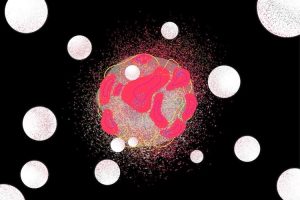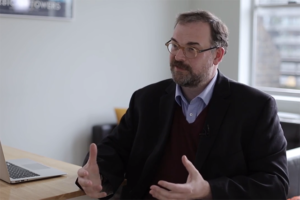Zebrafish Embryo
Biologist Egor Zadereev on the most favorite research organism of contemporary scientists
The video is a part of the project British Scientists produced in collaboration between Serious Science and the British Council.
Neuroscience is the science of neurons which is the active component, or the component responsible for thinking, acting, and perceiving in our brains. For more than a century people have been studying neurons and working out the biology of neurons and how they work, and grow, and interact with each other. Often looking at experiments with slices of brain in a dish, working at how neurons work at the microscopic level. In parallel, also for more than a century there’s been the study of psychology and behavior, so how we behave, perceive and remember things, and how we act in our daily life. At a certain point, the neuroscience and the study of cognition started to become interrelated where people began to realize that our brains are what generates our behavior and that it’s the neurons are the key elements in our brains that do that.
Maybe in the late 60s – early 70s this became a real topic and slowly began to expand. By the 1990s it became a big topic, it became clear that nearly all psychology departments would need to have some understanding of the relationship to the brain of the cognitive things they studied. And nearly all systems neuroscience departments that were interested in the biology of neurons would need to know something about what they actually do, how they generate brains and behavior, and perception.
In the mid 90s the University College London decided to set up an institute of cognitive neuroscience, where we are now. In this country, it was the first institute of cognitive neuroscience to bring together people from psychology, neurology, and neuroscience. They could all be in the same building to try to understand what they had in common about their knowledge of how the brain worked and how it helped us to behave, perceive, remember, and think. Now there are many subfields within cognitive neuroscience. People are interested in how we perceive the world around us, interested in vision, hearing, touch, and also, of course, in action, how we move, motor neuroscience. In the middle people are interested in higher cognitive thought, for example, memory, planning, decision-making. The traditional psychology department would have an interest in all of these different areas. Now people are interested in how the brain generates these different aspects of cognition. We see cognitive neuroscience has interest in all these different areas, too. We see a particularly exciting generation of new ideas coming all the way from understanding how neurons in visual cortex represent what we’re seeing, pioneered by Hubel and Wiesel’s work in the 60s.
Going all the way through to motor neuroscience and understanding how activity of neurons in the motor cortex, for example, via the spine actually controls muscle contractions and allows us to move. Then in the middle there’s the enormous area of cognition between perception and action which includes how we remember things that have happened to us before and how that can inform what we’re going to do next, and how we can think about the future, plan we’re going to do. And I haven’t even mentioned language which for humans is a very important area, though it’s a little bit harder to study it in animals.
Nowadays we see people who’ve come into the field of cognitive neuroscience neither from a standard psychology background or from neurology, or, perhaps, biology. We do see people from all of these areas coming into cognitive neurosciense, but also people who studied physics or engineering. Make it easy for them to design experiments or use new technologies which are coming online. So one of the drivers of the expansion in cognitive neuroscience, as well as the realization that the brain was the key to understanding many aspects of behavior and cognition, is the advance of technology. We see that in many different areas.
The big advances in cognitive neuroscience have come through people from different disciplines working together. Certainly, initially there weren’t really many departments of cognitive neuroscience and there weren’t students who trained in cognitive neuroscience. Obviously, cognitive scientists and neurologists, people who knew how to do functional neuroimaging, neuroscientists had to come together to interact, to explore new explanations that could be made of cognition and behavior given what we know about what’s happening in the brain. But that would sort of characterize the state of the field in the 1990s.
Now there are many cognitive neuroscience programs and there are students who have done degrees, or masters courses, or PhDs in cognitive neuroscience. So there are many sorts of modern researchers who perhaps would still consider themselves to be a psychologist, or a neuroscientist, or a physiologist. But now they’re able to use a range of techniques which allow them to study behavior and cognition at the same time as aspects of what’s happening in the brain. Nowadays, the modern cognitive neuroscientist is an interdisciplinary worker, but it’s becoming more of a mature field, so that you could say that you’re just a cognitive neuroscientist and that is your field.
There are several interesting developments in cognitive neuroscience at the moment which really exemplify the current direction of the field of understanding the brain and behavior. One of these is broadly mental health. For a long time, people understood psychiatry and clinical psychology in terms of treatments and drugs that happen to work and there’s a long history of experience with. But the actual mechanism of how that treatment actually changes the behavior or the aspects of cognition that are dysfunctional is not well understood, what that mechanism is not really known. Recently, there’s been a trend towards trying to understand what these mechanisms are both in healthy, normally processing people and how they’ve gone wrong in certain psychiatric or neurological conditions. So that we can try to understand behavioral interventions and pharmacological interventions in terms of the neural mechanisms that you want to restore or that you want to change back to how they should be. This area of mental health is becoming more of a science, more like neuroscience than a practical experience dependent field like medicine. That’s a big area in which there is a current advance.
The future for cognitive neuroscience is to make an actual practical impact on treatment in psychiatry, mental health, and neurology. Ideally, beginning to understand what the neural mechanisms are behind normal cognition and how aspects of cognition can go wrong should really begin to impact on treatment and therapy. The next ten years hopefully we’ll see a combination of mental health practices, psychiatry, and cognitive neuroscience, as we saw between psychology, cognitive science, and neuroscience in cognitive neurosciense. It will hopefully begin to put this kind of mental health medicine firm mechanistic background rather than having to rely essentially on treatments that we know work, but we don’t really know why they work.

Biologist Egor Zadereev on the most favorite research organism of contemporary scientists

Molecular oncologist Matthias Dobbelstein on targeted therapies, gene p53, and DNA damage

Historian of Science Simon Werret on the Russian Academy of Sciences, the foundation of Saint Petersburg, and...